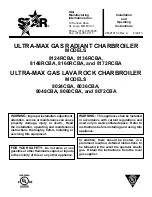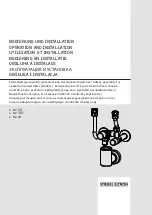
15.1 SERVICING
To ensure continued efficient operation of the appliance it
must be checked and serviced as necessary at regular
intervals. The frequency of servicing will depend upon the
particular installation conditions and usage, but once per
year should generally be adequate. The extent of the service
required by the appliance is determined by the operating
condition of the appliance when tested by fully qualified
engineers.
Any service work must be carried out by competent
engineers such as British Gas or Corgi registered personnel.
15. 2 PRE-SERVICE INSPECTION
Check that the flue terminal and the terminal guard, (if fitted), are clear.
If the appliance is in a compartment, check that the ventilation
openings in the compartment door or walls are clear. See Section
6 - Air Supply.
Check the system and remake any joints or fittings which show
signs of leakage. Refill, vent and re-pressurise as described in
Section 13.2.
Operate the appliance and the system taking note of any faults.
Measurement of the Flue Gases
For consistency of results of the flue gas measurements it is
necessary to have a constant output and stationary equilibrium.
Switch on the appliance.
Switch to DHW and CH mode.
Hinge down the facia.
Turn the Mode Switch to the “Max.” position.
Wait until the appliance reaches stationary equilibrium
(approx. 10 minutes).
Insert the probe into the flue duct.
Expected measurements should be between:
CO: 0.0015 and 0.0025%.
CO
2
: 4.5 - 5.5%.
After taking the measurement:
Turn the Mode Switch back to the “normal” position.
Put the facia back in to its normal position.
SAFETY
Disconnect the electrical supply at the mains and turn off the
gas supply at the gas service cock on the appliance before
servicing.
After completing the service always test for gas soundness as
indicated in BS 6891.
15. 3 COMPONENT ACCESS
To carry out a full and comprehensive service of the appliance
remove the following parts to gain access to the components
which need to be checked or serviced.
(a) Cabinet Front Panel.
Remove by lifting off the supports.
(b) Inner Casing Cover.
Check that the electricity supply to the
appliance is turned off. Remove the cabinet front panel. Unscrew the
four screws securing the cover to the casing and lift off. See Fig. 21.
(c) Facia Panel.
Check that the electricity supply to the appliance
is turned off. Remove the cabinet front panel. Unscrew the two
upper screws as shown in Fig. 21 and hinge down the facia
taking care not to distort the pressure gauge capillary tube or
electrical connections.
(d) Bottom panel.
Hinge down the facia panel. Disengage the
front edge of the bottom panel from the two clips and remove
the bottom panel from the appliance.
(e) Flue Hood Assembly.
Undo the two screws securing the flue
hood. Lift and slide the flue hood assembly from the appliance.
See Fig. 26. When refitting the hood ensure that the rear return
edge passes under the lip at the rear of the combustion chamber.
(f) Combustion Chamber Front and Sides.
Remove the inner
casing cover. Slacken off to the end of the thread but do not
remove the two wing nuts securing the combustion chamber.
Unhook the securing rods out of the locating holes in the
combustion chamber sides. Ease the combustion chamber front
and side assembly clear of the appliance. Refer to Fig. 26.
(g) Burner Assembly.
Remove the combustion chamber front
and sides. Pull off the two spark electrode leads and disconnect
the flame sense lead at the plastic connector under the inner
casing.
NOTE:
The flame sensing lead is attached to the burner.
When the burner is removed ensure this lead is fed through the
inner casing. Remove the grommet seal to allow the plastic
connection to pass through the inner casing. Unscrew the G
3
/
4
union nut on top of the gas valve and retain the sealing washer.
Unscrew the front burner fixing screw. Lift the burner and ease
the union nut through the inner casing sealing grommet.
Remove the burner assembly clear of the inner casing.
Ensure the flame sensing lead passes through the base of the
inner casing. See Fig. 27.
15. 4 SERVICE OF COMPONENTS
Clean the Main Burner.
Brush the blade tops and mixing tube
with a soft brush and check that all the flame ports are clear.
Remove any blockages with a non-metallic brush. Inspect the
injector and clean with a soft brush. Replace the injector if it
appears damaged. Do not use a wire brush or anything likely to
cause damage. Replace the spark and sense electrodes if they
appear damaged.
Clean the Gas to Water Heat Exchanger.
Cover the burner
manifold hole in the combustion chamber bottom panel with a
cloth. Clean the heat exchanger using a soft brush. Remove the
deposits from the bottom of the combustion chamber. Do not
distort any of the blades.
Combustion Chamber Insulation.
Examine and replace any
pads that are damaged. Remove any dust or deposits using a
soft brush after first dampening the pads.
Reassemble the appliance in the reverse order.
Check that all components are in place and correctly fixed. Leave
the cabinet front panel to be fitted after checking the operation
of the appliance.
15. 5 TEST THE APPLIANCE
On completion of the service and reassembly of the appliance,
check for gas soundness and the correct operation of the
appliance as described in Section 13-Commissioning.
Refit the cabinate front panel and reset the controls to the users
requirements.
15. Inspection And Servicing
18
Fig. 26. Appliance components and fixings
(upper assembly).
Flue hood
fixing
screws
Central
heating
sensor
Overheat
thermostat
Flue hood
Combustion
chamber
fixing bolts
(2)
Burner fixing screw
Combustion
chamber
front and
sides
Summary of Contents for 24CDi BF
Page 26: ...26 ...
















































